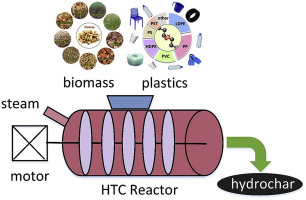Biomass & Bioenergy ( IF 6 ) Pub Date : 2020-01-28 , DOI: 10.1016/j.biombioe.2020.105479 Yafei Shen

|
Hydrothermal carbonization (HTC) as a promising thermochemical process can convert organic solid wastes (e.g., biomass, plastics) into valuable products (i.e., hydrochar) at relatively low temperatures (180–250 °C) and saturated pressures (2–10 MPa). Hydrothermal conversion generally occurs via dehydration, polymerization and finally carbonization reactions. The carbon materials derived from hydrochar have high potential in various applications such as solid fuel, supercapacitor, fuel cell, and sorbent. Although the energy densification of hydrochar was increased at higher temperatures, most of the benefit was achieved at modest temperatures. Chemical structures of hydrochars include crosslinks of aromatic polymer, surface porosity, organic functional groups and ultimate components. All of these characteristics can be changed significantly by HTC, influencing the reactivity and fuel properties of hydrochars. The reaction pathways including negative and positive effects during (co)-HTC of biomass and plastic wastes are thoroughly concluded. In particular, the co-HTC of chlorinated plastic (e.g., PVC) and biomass can enhance the dechlorination and inorganics removal from hydrochar.
中文翻译:

生物质和塑料废料的热液碳化成为能源产品的综述
水热碳化(HTC)作为一种有前途的热化学过程,可以在相对较低的温度(180-250°C)和饱和压力(2-10 MPa)下将有机固体废物(例如,生物质,塑料)转化为有价值的产品(例如,碳氢化合物)。 。水热转化通常通过脱水,聚合和最后的碳化反应发生。源自水焦的碳材料在各种应用中具有很高的潜力,例如固体燃料,超级电容器,燃料电池和吸附剂。尽管在较高温度下增加了碳氢化合物的能量致密化,但在适度的温度下可获得大多数好处。水碳的化学结构包括芳族聚合物的交联,表面孔隙率,有机官能团和最终组分。HTC可以对所有这些特征进行重大更改,影响水煤的反应性和燃料性质。彻底总结了生物质废料和塑料废料在(共)-HTC过程中产生负面和正面影响的反应途径。特别地,氯化塑料(例如PVC)和生物质的共同HTC可以增强脱氢和从烃中去除无机物。



























 京公网安备 11010802027423号
京公网安备 11010802027423号